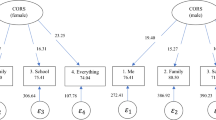Abstract
This chapter presents the process of integrating data from multiple methods of assessment and sources of data to generate a data-driven portrait (i.e., conceptualization) of a child’s functioning across multiple domains. The psychoeducational assessment process of integrating data and conceptualizing a child’s functioning is similar to, but likely more data-driven, than the case formulation process within a therapeutic framework. When conceptualizing a child’s functioning, it is important to be cognizant of scientific decision-making and mindful about straying too far from the data and into the realm of speculation or story creation. Following the presentation of how to conceptualize a child’s functioning, you will be in the position to offer a classification decision that is supported by the data. An example of each type of IDEA classification is presented.
Access this chapter
Tax calculation will be finalised at checkout
Purchases are for personal use only
Similar content being viewed by others
References
Achenbach, T. M., McConaughy, S. H., & Howell, C. (1987). Child/adolescent behavioral and emotional problems: Implications of cross-informant correlation for situational specificity. Psychological Bulletin, 101, 213–232.
Bower, E. M. (1982). Severe emotional disturbance: Public policy and research. Psychology in the Schools, 19, 55–60.
Dombrowski, S. C. (2015). Psychoeducational assessment and report writing. New York, NY: Springer.
Konold, T. R., Walthall, J. C., & Pianta, R. C. (2004). The behavior of child ratings: Measurement structure of the child behavior checklist across time, informants, and child gender. Behavioral Disorders, 29, 372–383.
Martin, R. P. (1988). Assessment of personality and behavior problems: Infancy through adolescence. New York: Guilford Press.
Author information
Authors and Affiliations
Corresponding author
Editor information
Editors and Affiliations
Rights and permissions
Copyright information
© 2020 The Editor(s) (if applicable) and The Author(s), under exclusive license to Springer Nature Switzerland AG
About this chapter
Cite this chapter
Dombrowski, S.C. (2020). Conceptualization and Classification. In: Dombrowski, S. (eds) Psychoeducational Assessment and Report Writing. Springer, Cham. https://doi.org/10.1007/978-3-030-44641-3_10
Download citation
DOI: https://doi.org/10.1007/978-3-030-44641-3_10
Published:
Publisher Name: Springer, Cham
Print ISBN: 978-3-030-44640-6
Online ISBN: 978-3-030-44641-3
eBook Packages: Behavioral Science and PsychologyBehavioral Science and Psychology (R0)




